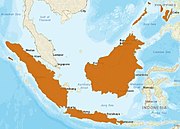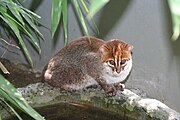Prionailurus
| Prionailurus[1] | |
|---|---|

| |
| Prionailurus species from top-left clockwise: Leopard cat (P. bengalensis), Sunda leopard cat (P. javanensis), flat-headed cat (P. planiceps), fishing cat (P. viverrinus) | |
| Scientific classification | |
| Domain: | Eukaryota |
| Kingdom: | Animalia |
| Phylum: | Chordata |
| Class: | Mammalia |
| Order: | Carnivora |
| Suborder: | Feliformia |
| Family: | Felidae |
| Subfamily: | Felinae |
| Genus: | Prionailurus Severtzov, 1858 |
| Type species | |
| Felis pardachrous Brian Houghton Hodgson, 1844 (= Felis bengalensis Kerr, 1792)
| |
| Species | |
|
See text | |

| |
| Prionailurus ranges | |
Prionailurus is a genus of spotted, small wild cats native to Asia.[2][3] Forests are their preferred habitat; they feed on small mammals, reptiles and birds, and occasionally aquatic wildlife.[4]
Taxonomy[edit]
Prionailurus was first proposed by the Russian explorer and naturalist Nikolai Severtzov in 1858 as a generic name for a single felid occurring in tropical Asia, namely Felis pardachrous described by Brian Houghton Hodgson — the leopard cat. As varieties, Severtzov lists Felis nipalensis described by Thomas Horsfield and Nicholas Aylward Vigors, Leopardus Elliotti, Leopardus Horsfieldi and Leopardus chinensis described by John Edward Gray, and Felis bengalensis described by Anselme Gaëtan Desmarest.[5]
The British zoologist Reginald Innes Pocock recognized the taxonomic classification of Prionailurus in 1917. In 1939, he described the genus on the basis of skins and skulls, and compared these to body parts of Felis. Prionailurus species are marked with spots, which are frequently lanceolate, sometimes rosette-like, and occasionally tend to run into longitudinal chains, but never fuse to form vertical stripes as in Felis. Skulls of Prionailurus are lower and less vaulted than of Felis. The facial part is shorter than the cranial, and the bottom of the orbit longer. The nasal bones are not everted above the anterior nares, and the outer chamber of the bulla is much smaller than the inner. Pocock classified the leopard cat, rusty-spotted cat and fishing cat as belonging to the genus Prionailurus.[2]
Pocock's classification of Prionailurus has been widely accepted, with five species now recognised:[6]
| Common name | Scientific name and subspecies | Range | Size and ecology | IUCN status and estimated population |
|---|---|---|---|---|
| Leopard cat | Prionailurus bengalensis[7] (Kerr, 1792) Two subspecies
|
continental South, Southeast and East Asia.
|
Size: Habitat: Diet: |
LC
|
| Sunda leopard cat | Prionailurus javanensis[8] (Desmarest, 1816) Two subspecies
|
Sundaland islands of Java, Bali, Borneo, Sumatra and the Philippines
|
Size: Habitat: Diet: |
|
| Flat-headed cat | Prionailurus planiceps[9] (Vigors & Horsfield, 1827) |
Thai-Malay Peninsula, Borneo and Sumatra.
|
Size: Habitat: Diet: |
EN
|
| Fishing cat | Prionailurus viverrinus[10] (Bennett, 1833) |
South and Southeast Asia
|
Size: Habitat: Diet: |
VU
|
| Rusty-spotted cat | Prionailurus rubiginosus[11] (Geoffroy Saint-Hilaire, 1834) |
Nepal, India and Sri Lanka
|
Size: Habitat: Diet: |
NT
|
Molecular analysis of leopard cat populations indicates a clear distinction between northern populations from Tsushima, Korea, Siberia, China and Taiwan and Southeast Asian populations. If these genetic differences indicate a specific distinction, P. b. euptilurus may yet be a valid species.[12]
The Iriomote cat (P. bengalensis iriomotensis) has been proposed as a distinct species based on morphology, but is considered a subspecies of P. bengalensis based on genetic analysis.[13]
Phylogeny[edit]
Phylogenetic analysis of the nuclear DNA in tissue samples from all Felidae species revealed that the evolutionary radiation of the Felidae began in Asia in the Miocene around 14.45 to 8.38 million years ago.[3][14] Analysis of mitochondrial DNA of all Felidae species indicates a radiation at around 16.76 to 6.46 million years ago.[15] Both models agree in the rusty-spotted cat having been the first cat of the Prionailurus lineage that genetically diverged, followed by the flat-headed cat and then the fishing cat.[3][15] It is estimated to have diverged together with the leopard cat between 4.31 to 1.74 million years ago[3] and 4.25 to 0.02 million years ago.[15]
The following cladogram shows their phylogenetic relationship as derived through analysis of nuclear DNA:[3][14]
|
References[edit]
- ^ Wozencraft, W. C. (2005). "Genus Prionailurus". In Wilson, D. E.; Reeder, D. M. (eds.). Mammal Species of the World: A Taxonomic and Geographic Reference (3rd ed.). Johns Hopkins University Press. pp. 543–544. ISBN 978-0-8018-8221-0. OCLC 62265494.
- ^ a b Pocock, R. I. (1939). "Genus Prionailurus Severtzow". The fauna of British India, including Ceylon and Burma. Mammalia. – Volume 1. London: Taylor and Francis. pp. 265–284.
- ^ a b c d e Johnson, W. E.; Eizirik, E.; Pecon-Slattery, J.; Murphy, W. J.; Antunes, A.; Teeling, E. & O'Brien, S. J. (2006). "The Late Miocene radiation of modern Felidae: A genetic assessment". Science. 311 (5757): 73–77. Bibcode:2006Sci...311...73J. doi:10.1126/science.1122277. PMID 16400146. S2CID 41672825.
- ^ Nowell, K. & Jackson, P. (1996). Wild Cats: status survey and conservation action plan. Gland, Switzerland: IUCN/SSC Cat Specialist Group. ISBN 9782831700458.
- ^ Severtzow, M. N. (1858). "Notice sur la classification multisériale des Carnivores, spécialement des Félidés, et les études de zoologie générale qui s'y rattachent". Revue et Magasin de Zoologie Pure et Appliquée. X: 385–396.
- ^ Kitchener, A. C.; Breitenmoser-Würsten, C.; Eizirik, E.; Gentry, A.; Werdelin, L.; Wilting, A.; Yamaguchi, N.; Abramov, A. V.; Christiansen, P.; Driscoll, C.; Duckworth, J. W.; Johnson, W.; Luo, S.-J.; Meijaard, E.; O’Donoghue, P.; Sanderson, J.; Seymour, K.; Bruford, M.; Groves, C.; Hoffmann, M.; Nowell, K.; Timmons, Z. & Tobe, S. (2017). "A revised taxonomy of the Felidae: The final report of the Cat Classification Task Force of the IUCN Cat Specialist Group" (PDF). Cat News (Special Issue 11): 23–29.
- ^ Kerr, R. (1792). "Bengal Tiger-Cat Felis bengalensis". The Animal Kingdom or zoological system of the celebrated Sir Charles Linnaeus. Class I. Mammalia. Edinburgh & London: A. Strahan & T. Cadell. pp. 151–152.
- ^ Desmarest, A. G. (1816). "Le Chat de Java, Felis javanensis Nob.". In Société de naturalistes et d'agriculteurs (ed.). Nouveau dictionnaire d'histoire naturelle, appliquée aux arts, à l'agriculture, à l'économie rurale et domestique, à la médecine. Tome 6. Paris: Chez Deterville. p. 115.
- ^ Vigors, N. A.; Horsfield, T. (1827). "Descriptions of two species of the genus Felis, in the collections of the Zoological Society". The Zoological Journal. III (11): 449–451.
- ^ Bennett, E. T. (1833). "Felis viverrinus". Proceedings of the Zoological Society of London. Part I: 68–69.
- ^ Geoffroy Saint-Hilaire, I. (1831). "Le Chat à Taches de Rouille, Felis rubiginosa (Nob.)l". In Bélanger, C.; Geoffroy Saint-Hilaire, I. (eds.). Voyage aux Indes-Orientales par le nord de l'Europe, les provinces du Caucases, la Géorgie, l'Arménie et la Perse, suivi des détails topographiques, statistiques et autre sur le Pégou, les Iles de Jave, de Maurice et de Bourbon, sur le Cap-de-bonne-Espérance et Sainte-Hélène, pendant les années 1825, 1826, 1827, 1828 et 1829. Tome 3: Zoologie. Paris: Arthus Bertrand. pp. 140−144.
- ^ Tamada, T. Siriaroonrat; B. Subramaniam, V.; Hamachi, M.; Lin, L.-K.; Oshida, T.; Rerkamnuaychoke, W.; Masuda, R. (2006). "Molecular Diversity and Phylogeography of the Asian Leopard Cat, Felis bengalensis, Inferred from Mitochondrial and Y-Chromosomal DNA Sequences". Zoological Science. 25 (2): 154–163. CiteSeerX 10.1.1.332.7592. doi:10.2108/zsj.25.154. PMID 18533746. S2CID 16057327.
- ^ Izawa, M. & Doi, T. (2016). "Prionailurus bengalensis ssp. iriomotensis". IUCN Red List of Threatened Species. 2016.
- ^ a b Werdelin, L.; Yamaguchi, N.; Johnson, W. E. & O'Brien, S. J. (2010). "Phylogeny and evolution of cats (Felidae)". In Macdonald, D. W. & Loveridge, A. J. (eds.). Biology and Conservation of Wild Felids. Oxford, UK: Oxford University Press. pp. 59–82. ISBN 978-0-19-923445-5.
- ^ a b c Li, G.; Davis, B. W.; Eizirik, E. & Murphy, W. J. (2016). "Phylogenomic evidence for ancient hybridization in the genomes of living cats (Felidae)". Genome Research. 26 (1): 1–11. doi:10.1101/gr.186668.114. PMC 4691742. PMID 26518481.





